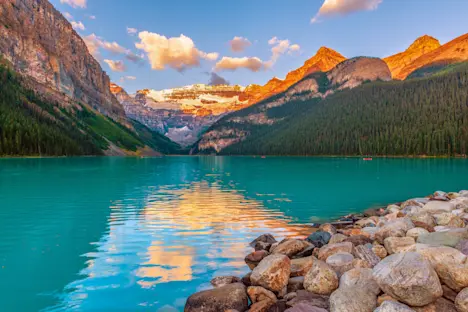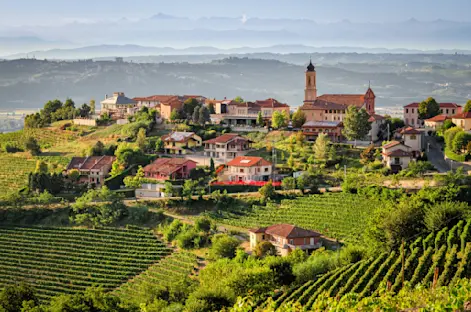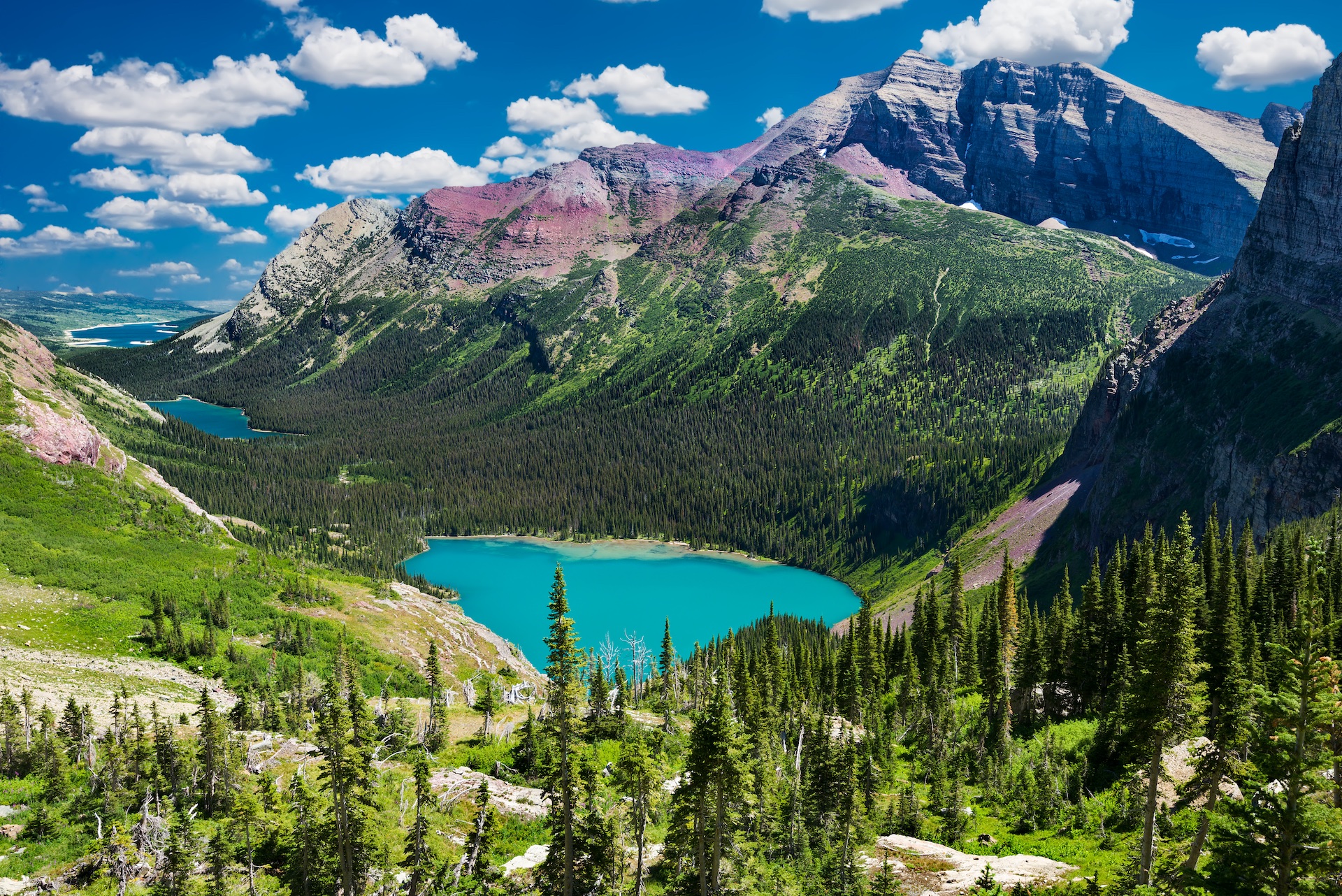It’s during the early daylight hours when Glacier National Park’s Many Glacier Valley is at its finest. The dramatic peaks of the Lewis Mountain Range take on a warm glow, while the waters of Lake Josephine glisten and shine with the rising fog of a fresh morning dew. Occasionally a moose wanders down a nearby trail, and a mama black bear and her cubs frolic in the fast-flowing creek just west of Lake Sherburne. At the Many Glacier Hotel, where I worked a summer waiting tables in its Ptarmigan Dining Room, the views are even more spectacular—with the triangular-shaped Grinnell Point rising above the waters of Swiftcurrent Lake like the perfect postcard image. There’s nothing quite like living in the middle of this “Switzerland of North America,” especially its Many Glacier Valley—one of this national park’s most impressive and awe-inspiring spots.
Tucked away on Glacier’s eastern side, about 12 miles into the park itself, the Many Glacier Valley is a stunning display of sparkling lakes, gushing waterfalls, rising mountains and alpine meadows that are often brimming with wildflowers like purple lupine and red-and-yellow gaillardia. The area is home to at least a dozen trailheads, ranging from a 4.2-mile round-trip meander to Red Rock Falls to a 12-mile out-and-back trek to Cracker Lake, a turquoise alpine wonder that often attracts moose and marmots, as well as grizzlies that chow down at berry patches along the trail. “Many” (the valley’s shortened nickname) is also the site of one of the park’s most celebrated—though quickly disappearing—glaciers, along with several lodging options, including the Many Glacier Hotel, the crowning jewel of the park’s railway-built hotels.
While the valley is typically open for visitors from early June to mid-September, it’s worth bedding down here for at least a few nights to take in all that the area has in store. Thankfully, Nat Hab’s Glacier & Waterton: An International Treasure adventure brings travelers into the heart of Many Glacier and includes a stay at its storied hotel.
If you plan to do a little exploring on your own, here are my favorite highlights of the Many Glacier Valley—a place I called home for an entire season.

The Many Glacier Hotel. Keep an eye out for wildlife such as bighorn sheep, bald eagles and grizzly bears along the trails, and summer meadows brimming with beargrass and Indian paintbrush.
The Many Glacier Hotel
The once-prominent Great Northern Railway built about a dozen lodging properties in and around Glacier National Park during the early 20th century, and the Many Glacier Hotel was among its finest. This five-story, Swiss chalet-style property perched on the shores of Swiftcurrent Lake in a remote part of the park opened in completion in 1917 and still stands as a testament to the railway and the national park system. It’s both the largest and grandest of Glacier’s lodgings and remains its showpiece. While partially renovated in 2016, visitors still won’t find televisions or air-conditioning in any of the 200+ guestrooms, and the hotel’s historic appeal—including its rustic architecture—remains intact.
These days, the hotel is buzzing with both lodgers and day-trippers who gather around its massive lobby fireplace to warm their boots and pore over trail maps, or dine on rainbow trout and bison burgers in the lakeside dining room. The Glacier Park Boat Company offers scenic cruises along the valley’s Swiftcurrent and Josephine lakes that leave from the hotel, while other local activities include horseback riding adventures along Many’s dense forest trails and Red Bus tours aboard one of Glacier’s 33 original “jammer” buses. These open-air vehicles have been navigating the park’s roadways—including the legendary 55-mile-long Going-to-the-Sun Road—since 1936.

Going-to-the-Sun Road crosses the Crown of the Continent, providing access to the awe-inspiring alpine lakes, knife-edged ridgelines and craggy mountaintops that George Bird Grinnell so admired.
Grinnell Glacier
There are only about 25 official glaciers remaining today in Glacier National Park—a drastic reduction from the 80 glaciers that existed here in 1850. In fact, all the park’s glaciers are expected to melt within this century, including the valley’s Grinnell Glacier. The glacier is named for George Bird Grinnell, a naturalist, conservationist and explorer who made frequent visits to the region in the late 1800s and staunchly advocated for the area to become a national park (which finally occurred in 1910). It’s one of the park’s most famous glaciers and has become a poster child for climate change.
Thanks to a series of photographs dating back to the mid-19th century, people can see Grinnell’s recent shrinkage firsthand. In 1850, the glacier measured 710 acres—the size of approximately 538 football fields. This acreage included a nearby glacier called Salamander Glacier, which at the time was attached to Grinnell. However, between 1966 and 2005, Grinnell shrank by nearly 40%. An increase in greenhouse gas emissions has played a huge role in its reduction.
What remains of the glacier sits above 6,510 feet on the north flank of the park’s Mount Gould, and it’s one of the park’s only glaciers that can be easily reached on foot. The Grinnell Glacier Trail is an 11.2-mile out-and-back route beginning at Swiftcurrent Lake. Although relatively challenging, the hike offers some spectacular scenery, including stunning mountain vistas and a trailside waterfall, as well as a high chance of spotting grizzlies (remember to make noise and let them know you’re coming!).
On a narrated boat tour across Swiftcurrent Lake, Nat Hab travelers take in the panorama of Mount Grinnell, Angel Wing and surrounding peaks. Learn about the geology and ecology of our environs as we get within view of Grinnell Glacier, an experience future visitors may be less likely to have as climate change hastens the melting of the park’s permanent ice features. Depending on the angle of the sun, the lake may appear opaque turquoise, the result of glacial silt suspended in the water as it flows down the mountain from Grinnell Glacier. Then on a hike to Grinnell Lake, look for grazing elk in the meadows, and mountain goats and bighorn sheep perched on cliffs.
Iceberg Lake
Glacier is home to more than 700 lakes, many of which are unnamed. Iceberg Lake is among its finest. This turquoise body of water gets its name from the many icebergs that often float in it—a result of the lake’s shadowy location among a series of towering peaks. It sits at 6,094 feet in elevation and is reachable via a 9.3-mile out-and-back trail that begins behind the Swiftcurrent Motor Inn. While moderately challenging, this half-day hike rewards with alpine meadows blooming with wildflowers like yellow columbine and white mountain death camas, dense pine forest that offers reprieve from the hot sun, and a pristine view of the Ptarmigan Wall, a narrow ridgeline separating the Many Glacier and Belly River valleys. That’s all before reaching the lake itself—an absolute sight to behold and an ideal spot for a picnic.

Ptarmigan Tunnel
Many Glacier’s Ptarmigan Tunnel was a project of the Civilian Conservation Corps, a part of America’s work relief program that ran from 1933 to 1942. Volunteer workers constructed this 240-foot tunnel through Ptarmigan Wall as a way for hikers and horses to avoid an even more strenuous climb when traveling between the Many Glacier and Belly River valleys. The tunnel is accessible via the Ptarmigan Tunnel Trail, which begins in the Many Glacier Valley from the same trailhead as Iceberg Lake.
This challenging 10.6-mile out-and-back hike provides spectacular views of the nearby peaks, including 8,851-foot Mount Grinnell and 8,436-foot Swiftcurrent Mountain, passes among occasional snowfields, and winds alongside thickets of huckleberries—a grizzly bear favorite. Bighorn sheep and mountain goats are often easy to spot. A series of long switchbacks make up the hike’s final portion, ending at the tunnel itself, which sits at an altitude of 7,200 feet. On its far side, 9,480-foot Natoas Peak and Elizabeth Lake make for picture-perfect vistas.
Join a National Park Adventure with Nat Hab
From early-morning alpenglow to glacier-fed lakes and high-country trails, the Many Glacier Valley showcases some of Glacier National Park’s most soul-stirring terrain. Whether you’re hiking past beargrass-lined meadows, paddling across turquoise lakes or exploring storied chalets, this region offers nature travelers a full-spectrum mountain experience. With Nat Hab as your guide, you’ll discover the legacy, wonder and wildness that define the Crown of the Continent.































